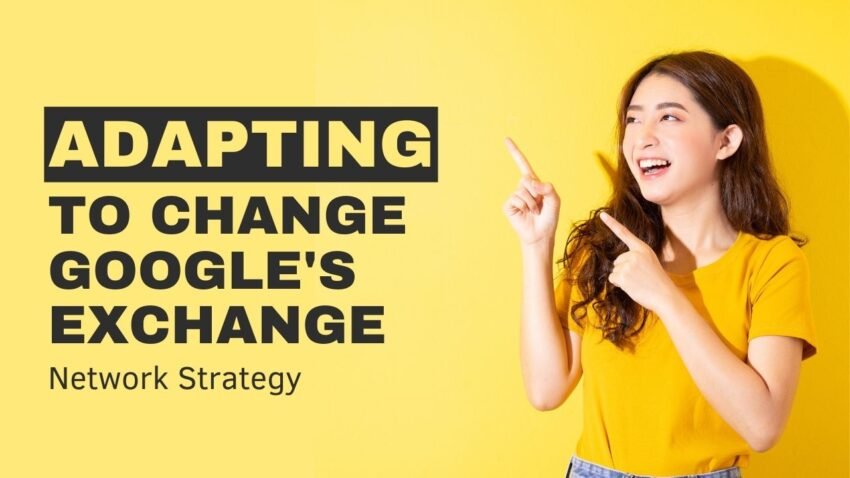
Adapting to Change: Google’s Exchange Network Strategy
Change is the only constant, they say, and Google certainly knows a thing or two about adapting. In the ever-evolving landscape of the internet, Google’s Exchange Network Strategy stands out as a prime example of how a tech giant navigates shifts in the digital realm. But what exactly is this strategy, and how does it affect us? Let’s dive in.
Google AdX vs. AdSense: What’s the Difference?
1. Understanding Google’s Exchange Network
Imagine the internet as a bustling marketplace, where advertisers are eager to showcase their products and services, and publishers are the vendors offering spaces for these advertisements. Google’s Exchange Network operates as the mediator, facilitating transactions between advertisers and publishers seamlessly.
Here’s a breakdown of how it works:
- Ad Inventory: Publishers offer ad space on their websites or apps. This ad space can be in various formats like display banners, video ads, native ads, etc.
- Demand-Side Platforms (DSPs): Advertisers, or buyers, use DSPs to bid on ad inventory. These platforms allow advertisers to manage their digital ad campaigns programmatically, setting parameters like target audience, budget, and bid prices.
- Supply-Side Platforms (SSPs): Publishers utilize SSPs to manage and optimize the sale of their ad inventory. SSPs enable publishers to connect with multiple ad exchanges, DSPs, and networks, maximizing their revenue from digital advertising.
- Ad Exchange: Google’s Exchange Network acts as a marketplace where ad inventory from publishers is made available for purchase by advertisers. It facilitates real-time bidding (RTB) where DSPs submit bids for ad impressions based on various targeting criteria and bidding strategies.
- Real-Time Bidding (RTB): When a user visits a webpage or uses an app with available ad space, an auction is triggered in real-time. Advertisers submit bids through DSPs, and the winning bid gets their ad displayed to the user.
- Ad Serving: Once the winning bid is determined, the ad creative is served in the ad space on the publisher’s website or app in real-time. This process happens within milliseconds, ensuring that the most relevant and valuable ad is displayed to the user.
Overall, Google’s Exchange Network streamlines the buying and selling of digital ad inventory, making the process more efficient and effective for both advertisers and publishers. It leverages technology to automate and optimize ad transactions, resulting in more targeted ads, higher revenue for publishers, and better ROI for advertisers.
2. Evolution of Online Advertising
Gone are the days of traditional advertising methods ruling the roost. With the advent of the internet, advertising has undergone a profound transformation. From banner ads to targeted ads, the evolution has been staggering, with Google often leading the charge.
Here’s a brief overview of its key stages:
- Banner Ads (1990s): The earliest form of online advertising, banner ads, were simple graphics displayed on web pages. They were often static and had limited targeting capabilities.
- Pop-up Ads (Late 1990s – Early 2000s): Pop-up ads emerged as a more intrusive form of advertising, appearing in separate windows that popped up over the content a user was viewing.
- Search Advertising (Early 2000s): With the rise of search engines like Google, advertisers began bidding on keywords to display their ads alongside search results. This marked the beginning of pay-per-click (PPC) advertising.
- Contextual Advertising (Mid-2000s): Contextual advertising became popular, where ads were matched to the content of the web page being viewed or the user’s search queries. Google AdSense pioneered this approach.
- Social Media Advertising (Late 2000s – Present): The advent of social media platforms like Facebook, Twitter, and Instagram introduced a new avenue for advertisers to target users based on their demographics, interests, and behaviors.
- Mobile Advertising (2010s – Present): As smartphones became ubiquitous, mobile advertising grew rapidly. Ad formats optimized for mobile devices, such as interstitial ads and in-app ads, became prevalent.
- Native Advertising (2010s – Present): Native ads blend seamlessly with the content of the platform they appear on, providing a less intrusive and more engaging advertising experience. This includes sponsored content, promoted posts, and native display ads.
- Programmatic Advertising (2010s – Present): Programmatic advertising uses algorithms and real-time bidding to automate the buying and placement of ads, allowing for highly targeted and efficient campaigns across a wide range of websites and platforms.
- Video Advertising (2010s – Present): The popularity of online video platforms like YouTube led to the rise of video advertising, including pre-roll, mid-roll, and post-roll ads, as well as native video ads on social media platforms.
- Ad Blocking and Ad Fraud (2010s – Present): As online advertising has become more pervasive, so too have challenges like ad blocking by users and ad fraud by unscrupulous actors, prompting advertisers and platforms to adopt measures to combat these issues.
- Privacy Concerns and Regulation (2010s – Present): Growing concerns about online privacy, particularly regarding the collection and use of personal data for advertising purposes, have led to increased scrutiny and regulation, such as the GDPR in Europe and the CCPA in California.
- Emerging Technologies (Present – Future): Technologies like augmented reality (AR), virtual reality (VR), and voice assistants are opening up new possibilities for immersive and interactive advertising experiences, shaping the future of online advertising.
Overall, online advertising has evolved from simple banner ads to a highly sophisticated ecosystem driven by data, automation, and targeted messaging, with constant innovation shaping its trajectory.
3. The Rise of Programmatic Advertising
Programmatic advertising, the automated buying and selling of online ads, has revolutionized the industry. It’s like having a personal shopper for ads, analyzing data in real-time to deliver the most relevant content to the right audience at the right moment.
Unlocking Success: Key Strategies for Google’s Ad Exchange Network
4. What is Google’s Exchange Network?
Google’s Exchange Network, also known as Ad Exchange or AdX, is the platform where programmatic buying and selling of display ads take place. It’s essentially the marketplace where advertisers bid for ad space, and publishers offer their inventory, all in real-time.
5. Benefits of Google’s Exchange Network
Google’s Exchange Network, also known as Google Ad Exchange or AdX, offers several benefits for publishers and advertisers:
- Access to Premium Inventory: AdX provides access to premium ad inventory from a vast network of publishers, including Google-owned properties like YouTube and Gmail, as well as numerous third-party websites and apps.
- Increased Monetization Opportunities: Publishers can maximize their revenue potential by tapping into AdX’s auction-based ad serving model, which often leads to higher CPMs (Cost Per Thousand Impressions) compared to traditional ad networks.
- Advanced Targeting Options: AdX offers sophisticated targeting capabilities, allowing advertisers to reach specific audiences based on factors like demographics, interests, browsing behavior, and more. This precision targeting helps advertisers improve the effectiveness of their campaigns.
- Real-Time Bidding (RTB) Integration: AdX operates on a real-time bidding platform, enabling advertisers to bid on ad impressions in milliseconds based on their targeting criteria and campaign goals. This dynamic bidding process ensures efficient ad serving and optimal campaign performance.
- Brand Safety and Quality Controls: AdX employs rigorous quality controls and brand safety measures to protect advertisers from ad fraud, inappropriate content, and other risks. This helps maintain a high-quality advertising environment for brands and ensures a positive user experience for audiences.
- Unified Reporting and Analytics: AdX provides comprehensive reporting and analytics tools that give both publishers and advertisers insights into their ad performance, audience engagement, and revenue metrics. This data-driven approach enables them to optimize their strategies and maximize their ROI.
- Integration with Google’s Ad Ecosystem: AdX seamlessly integrates with other Google advertising products, such as Google Ads (formerly AdWords) and Google Ad Manager (formerly DoubleClick for Publishers), offering a unified platform for managing and optimizing ad campaigns across various channels and formats.
Overall, Google’s Exchange Network offers a powerful and scalable advertising solution for publishers and advertisers alike, providing access to premium inventory, advanced targeting capabilities, real-time bidding technology, and robust reporting tools to drive better results and maximize revenue opportunities.
6. Challenges and Criticisms
- Privacy Concerns: The collection and utilization of user data raise valid privacy concerns, prompting debates over ethical practices and data protection regulations.
- Ad Fraud: The automated nature of programmatic advertising opens the door to fraudulent activities, such as ad stacking and bot traffic, undermining the integrity of the ecosystem.
- Dependency on Google: Some critics argue that Google’s dominance in the online advertising space poses a risk of monopolization, stifling competition and innovation.
7. Impact on Publishers and Advertisers
For publishers, Google’s Exchange Network offers a lucrative opportunity to monetize their content effectively. By tapping into a vast network of advertisers, publishers can maximize their revenue streams and sustain their operations.
Advertisers, on the other hand, benefit from access to premium inventory and advanced targeting options. With the ability to reach their desired audience with tailored messages, advertisers can optimize their marketing campaigns for better results.
8. Future Trends and Innovations
As technology continues to advance, we can expect Google’s Exchange Network to evolve accordingly. From enhanced targeting capabilities to improved ad formats, the future holds promising innovations that will further optimize the advertising ecosystem.
Conclusion
In conclusion, Google’s Exchange Network is a testament to the company’s ability to adapt to change and innovate in the digital advertising landscape. By leveraging technology and data-driven insights, Google continues to shape the future of online advertising, offering benefits for both advertisers and publishers alike.
Unlocking Success: Innovative Strategies with Google’s Exchange Network
FAQs About Google’s Exchange Network
1. What makes Google’s Exchange Network different from other ad networks?
Google’s Exchange Network stands out for its emphasis on programmatic buying and selling, offering real-time auctions for ad space and advanced targeting options for advertisers.
2. How does Google ensure the integrity of its Exchange Network amid concerns about ad fraud?
Google employs sophisticated algorithms and stringent quality control measures to detect and mitigate ad fraud, safeguarding the integrity of its Exchange Network.
3. Can small publishers benefit from participating in Google’s Exchange Network?
Yes, small publishers can access Google’s Exchange Network through various intermediary platforms, allowing them to monetize their content and reach a broader audience effectively.
4. Are there any risks associated with relying solely on Google’s Exchange Network for advertising needs?
While Google’s Exchange Network offers many benefits, relying solely on it for advertising needs can pose risks, such as dependency on a single platform and potential exposure to policy changes or algorithm updates.
5. How can advertisers optimize their campaigns on Google’s Exchange Network for better results?
Advertisers can optimize their campaigns by leveraging data insights, testing different ad formats and targeting strategies, and staying updated on industry trends and best practices.








Leave a Reply